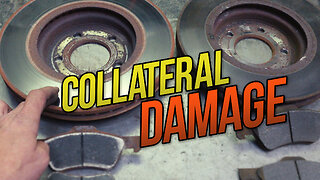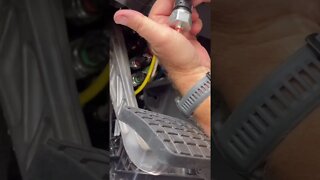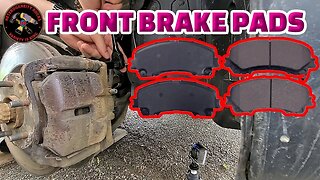How To Diagnose a Locked Up Brake Caliper and/or Dragging Brakes
In this video I'll show you how to diagnose a locked up brake caliper and/or dragging brakes for one wheel. Usually, when brakes lock up on one wheel its caused by either a locked up caliper piston, stuck caliper slide pins, or a clogged flex hose going to the caliper. This video will give information on how to test each of these components in order to get a better idea of what is causing your brake problem.
!!Warning!! If your brakes are locked up its going to be very hot just after driving. The whole area that is affected is going to be very hot. Let the vehicle cool down before attempting to diagnose the problem. Don't touch a hot rotor or any hot brake component! Injury can occur. An infrared thermometer would be suggested to verify that the area is cool enough to work on.
Note: This video is designed to only diagnose brakes locked up on one single wheel. If your brakes are locking up on more than one wheel this video may help you but may not help you with all possible causes of your symptom.
Note: when collapsing a caliper piston on a caliper with more than one piston as shown at the 2:55 mark use care not to allow the other piston or pistons (calipers can come equipped with one, two, or even more pistons) to be pushed out by the build up of pressure inside the caliper. Notice the brake pad in the video is being used to prevent this from happening. If the opposite piston were to start to move outward, when using the method shown, then try bracing the piston using some other method to prevent it from coming out. You don't want your piston to be pushed out all the way. This can cause damage and brake fluid leaks.
Also, if any air has gotten into the system during testing, which is entirely possible, then you will need to bleed the system of air. And, it should go without saying, but I’ll say it. Everything that was loosened or taken off during testing will need to be reinstalled and tightened down properly.
At about the 1:59-2:35 mark I discus how the piston is supposed to retract back into the piston bore because of a seal inside the piston bore. If the piston is seized up on the bore then this seal will not be able to pull the piston back. The test we perform by compression the piston back into the caliper is meant to check to see if the piston is seized in the caliper bore which would prevent the seal from pulling the piston back....Just in case that needed clarification.
Also, for rear brakes, problems with the parking brake system could lead to rear brakes locking up on one or both sides of the vehicle. This video is not meant to aid in diagnosis of such situations. There is also a very small chance that air in the brake system could cause a caliper to lock up. This is very rare.... so rare that I've never seen it. This video is also not designed to diagnose a case such as this.
This video is also not intended to assist in diagnosis of drum brakes.
Here are links to other great videos that may help you!
Four Ways to Collapse a Caliper Piston
https://youtu.be/3RYG0ymWEFE
How to collapse/ compress a twist in rear brake caliper
https://youtu.be/hQfV0b75hgI
How to bleed brakes using the buddy system
https://youtu.be/6DeuMPgQDrE
Here is a link to a video that features a locked up caliper caused by a clogged flex hose: https://youtu.be/kD8sBecArkE
Disclaimer:
Barbour's Auto Help is not responsible for any damage or personal injury incurred in the process of performing any auto repairs done by you the viewer. Auto repair and diagnostics are very dangerous. Repair and diagnose your vehicle at your own risk. It is the viewers responsibility to verify all information and procedures as outlined in YOUR REPAIR MANUAL AND OWNERS MANUAL FOR YOUR VEHICLE. Owning and using a repair manual suited for your vehicle is essential for correctly and safely performing ANY repair to your vehicle. Always wear safety glasses and heed all instructions for use applicable to any piece of equipment you may use. Also, I make no guarantee that the information given in this video is completely accurate for all situations and applications. I also make no guarantee that you will make a proper diagnosis for your problem by using this video. Use the information found in this video at your own risk.
-
 6:34
6:34
Barbour's Auto Help
5 years agoHow I Diagnosed a Seized Caliper Piston
24 -
 2:29
2:29
Barbour's Auto Help
5 years agoLocked Up Caliper By Clogged Brake Hose
13 -
![[EASY FOLLOW] rear brake pads rotors Toyota Camry √ Fix it Angel](https://hugh.cdn.rumble.cloud/s/s8/1/Z/F/N/F/ZFNFj.0kob-small-EASY-FOLLOW-rear-brake-pads.jpg) 4:20
4:20
Fix it Angel Car Repair Channel
9 years ago[EASY FOLLOW] rear brake pads rotors Toyota Camry √ Fix it Angel
2 -
 3:43
3:43
Mechanic Secrets
1 year ago $0.02 earnedFrozen Brake Caliper Tips
871 -
 32:32
32:32
DuckmanCycles and VW Garage
1 year agoMy Parking Brake Lever Went Limp! - VW Rear Disc Cable Replacement
35 -
 0:32
0:32
Freight Relocators
1 year agoFreightliner Cascadia: Park Brake Air Low, Brakes May Drag. The Fix!
16 -
 18:19
18:19
Ridout
9 months agoHow to replace your front brake pads. #brake #mechanic
77 -
![[easy] front brake pad Replacement Mazda 626 √ Fix it Angel](https://hugh.cdn.rumble.cloud/s/s8/1/J/H/N/F/JHNFj.0kob-small-easy-front-brake-pad-Replac.jpg) 2:11
2:11
Fix it Angel Car Repair Channel
10 years ago[easy] front brake pad Replacement Mazda 626 √ Fix it Angel
3 -
 2:46
2:46
gofasthavefun.ca
4 years agoBrake Pedal SWITCH Maintenance (Brake Lights not working) | AnthonyJ350
2 -
 4:37
4:37
Fix it Angel Car Repair Channel
8 years agoEASY FOLLOW replace front brake pads rotors Toyota Matrix √ Fix it Angel
5